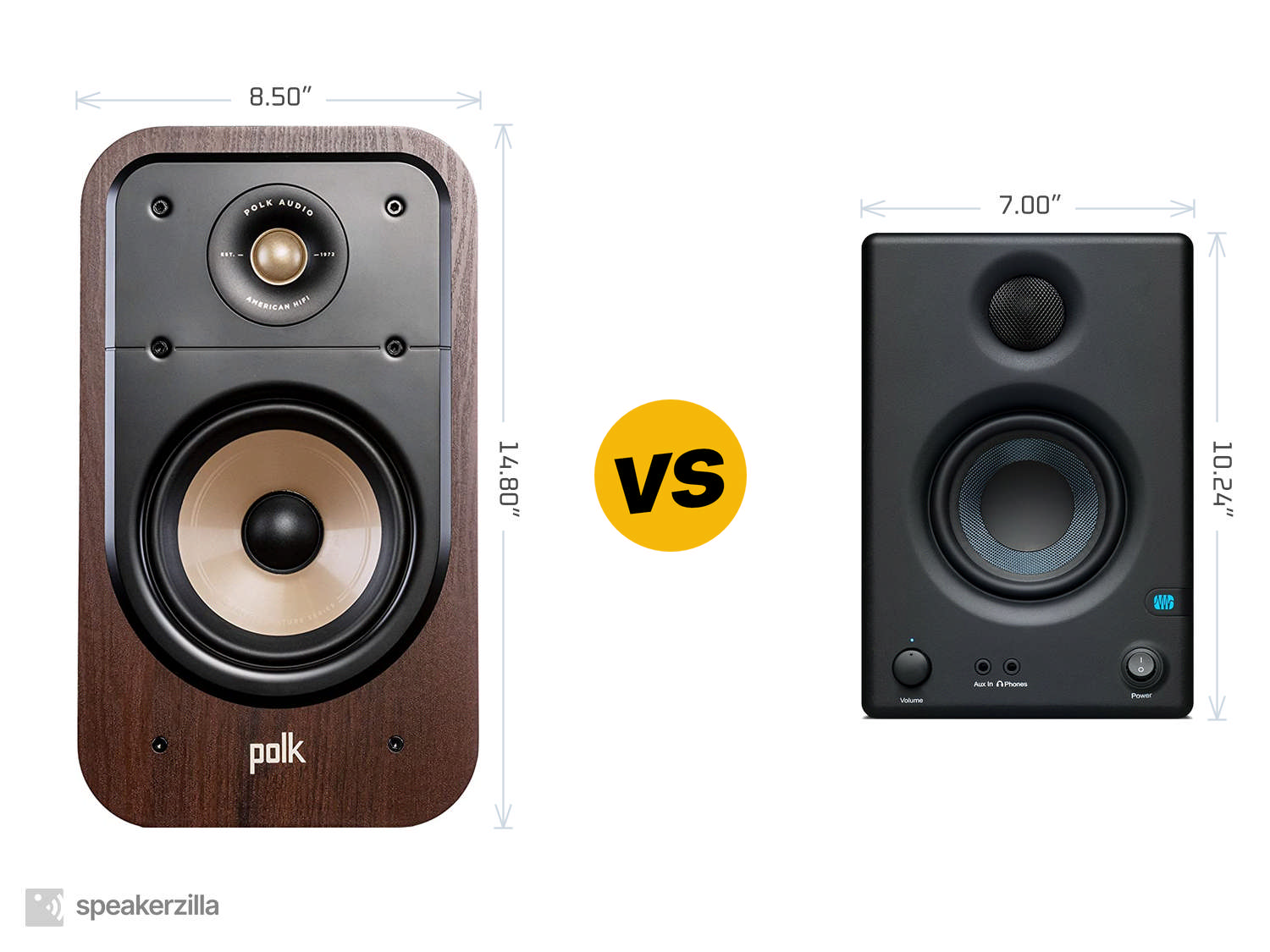Polk Signature Elite ES20 vs. Presonus Eris E3.5

| Polk Audio Signature Elite ES20 Bookshelf Speakers | Presonus Eris E3.5 3.5” Near Field Studio Monitor |
| MSRP | |
| $400 | $100 |
| Dimensions (H × W × D) | |
|
14.80” × 8.50” × 13.80” 376mm × 216mm × 351mm |
10.24” × 7.00” × 7.68” 260mm × 178mm × 195mm |
| Power Type | |
| Passive | Powered |
| Frequency Response | |
| 44-40,000 Hz | 80-20,000 Hz |
| ASR Score | |
| n/a | 1.5 |
| ASR Score w/Subwoofer | |
| n/a | 4.3 |
|
Amazon.com
|
Amazon.com
|
Key Takeaways
TLDR Summary: The Polk Audio Signature Elite ES20 bookshelf speakers and the PreSonus Eris E3.5 studio monitors cater to different audio enthusiasts. The ES20s, part of Polk's revered Signature line, deliver a warm and expansive soundstage ideal for home theater setups, leveraging their robust build and patented acoustic technologies. Meanwhile, the Eris E3.5s are compact near-field monitors designed for accuracy in sound reproduction, favored by content creators and musicians for their flat response and studio-centric performance. Choosing between them hinges on whether one prioritizes immersive listening experiences or precise audio editing and mixing capabilities.
Speaker Comparison
When it comes to selecting speakers for your audio setup, the decision can be as nuanced as a fine wine selection. With the Polk Audio Signature Elite ES20 Bookshelf Speakers and the PreSonus Eris E3.5 3.5” Near Field Studio Monitors gracing the market, it's a showdown between a lush home audio heavyweight and a nimble studio monitoring maestro. Whether nestled in a cozy living room or perched on a desk in a home studio, these two speaker sets cater to different ears with equally compelling arguments.
Design and Build: Aesthetics Meets Practicality
In terms of aesthetics, the Polk Audio Signature Elite ES20 speakers boast a handsome, modern look that's likely to complement a home theater setup with grace. They exude an air of premium quality, with a furniture-grade finish that speaks to their durability and Polk's attention to design detail. On the other hand, the PreSonus Eris E3.5 has a more utilitarian design that prioritizes function over form. These compact monitors are built for the studio environment, where space is at a premium, and the focus is on sound accuracy above all else.

 (at Amazon.com)
(at Amazon.com)Sound Profile: Warmth versus Accuracy
The sonic characteristics of the Polk ES20 and the Eris E3.5 are reflective of their intended environments. The Polk ES20s produce a warm, rich sound that's well-suited to a variety of content, from blockbuster movies to jazz ensembles. They feature Polk's proprietary Dynamic Balance technology, ensuring a wide soundstage and precise imaging that's a delight in a home setting. Conversely, the Eris E3.5 monitors are designed with flat frequency response in mind, offering the true sound needed for critical listening during content creation. Their sound is meant to reveal imperfections, ensuring mixes translate well to other listening environments.
Power and Performance: Room-Filling Sound vs. Intimate Detail
When comparing power handling, the ES20s stand out with their ability to handle up to 125 watts, filling a room with ease. Their performance is robust and confident, with bass that's surprising for their size, thanks to Polk's Power Port technology that provides deeper bass response. The Eris E3.5, with a modest 25 watts of power per speaker, doesn't thunder in the same way, but they shine in delivering balanced tones and detail that can be critical when mixing tracks or editing audio. They are near field monitors meant to perform in closer quarters where the nuances of sound are paramount.

 (at Amazon.com)
(at Amazon.com)Connectivity also sets these two contenders apart. The Polk ES20 speakers use traditional speaker wire connections, fitting seamlessly into existing hi-fi systems. The Eris E3.5 monitors include TRS and RCA inputs, along with the added convenience of a front-panel auxiliary input and headphone output, catering to the modern producer's needs for versatility in a studio environment.
Compare to similar speakers
An additional point of divergence lies in their adaptability. The ES20s are passive speakers, requiring an external amplifier or receiver, which offers listeners the flexibility to tailor their sound system's power and character. The Eris E3.5 speakers are active, with built-in amplification tailored specifically for the speakers' drivers. This all-in-one approach simplifies setup and ensures optimized performance without the need for additional equipment.
In conclusion, the choice between the Polk Audio Signature Elite ES20 Bookshelf Speakers and the PreSonus Eris E3.5 Near Field Studio Monitors will ultimately rest on the listener's ears and what they're looking to extract from their audio experience. The ES20s are a stellar choice for those wishing to immerse themselves in a rich, expansive sound in their living rooms. Meanwhile, the Eris E3.5s stand as a beacon for audio purists who demand the transparent, uncolored sound necessary for professional audio work. Each set of speakers embraces its purpose with confidence, ensuring that no matter your acoustic preference, there's a sound out there waiting to resonate with your soul.
- Polk Signature Elite ES20 reviews and FAQs
- Presonus Eris E3.5 reviews and FAQs
Check Current Prices: |
|
|
Amazon.com
|
Amazon.com
|
Affiliate Disclosure: As an Amazon Associate, we earn from qualifying purchases.

